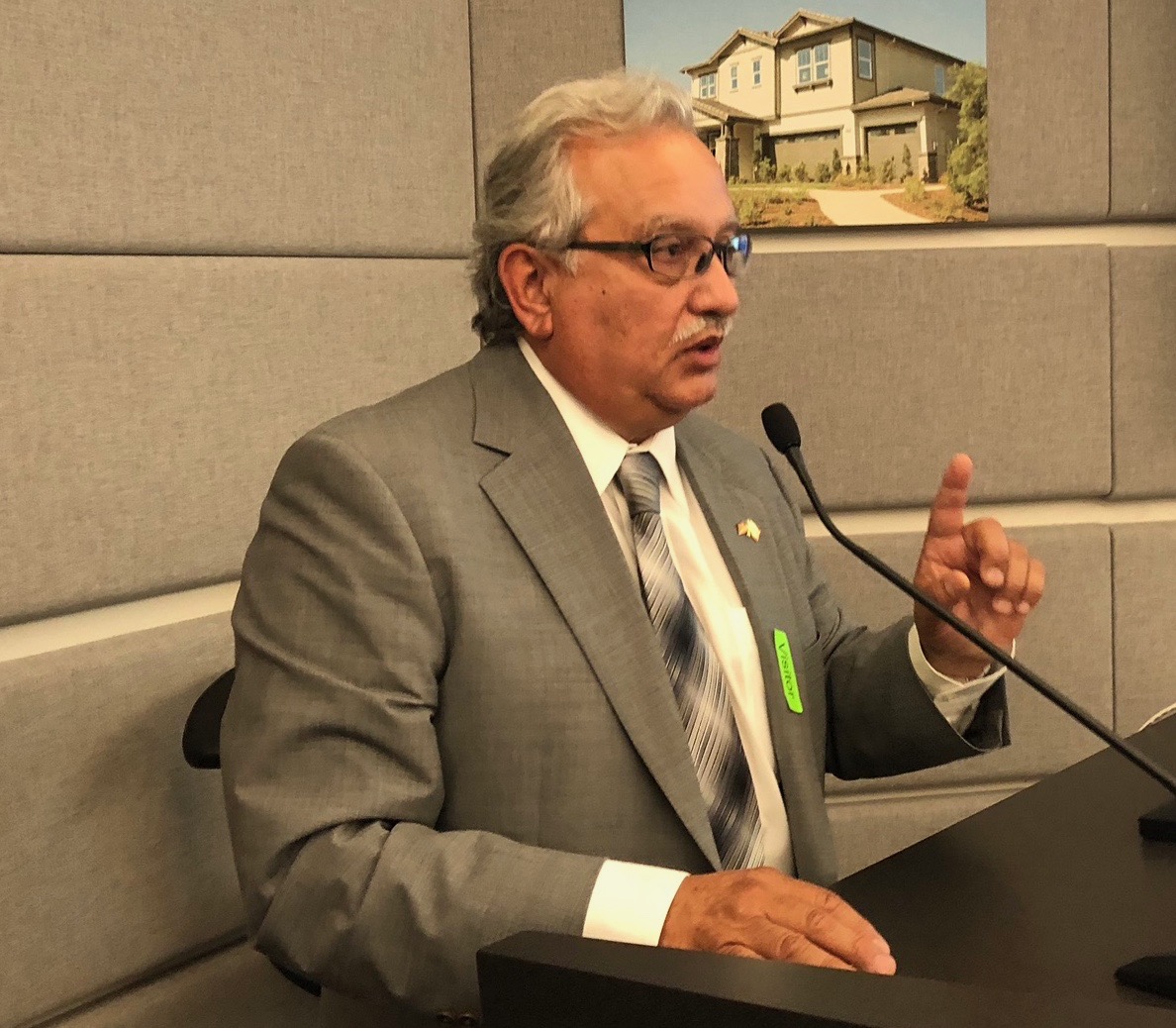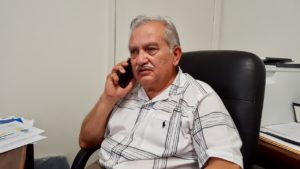
A Conversation with Mario Santoyo
Mario Santoyo is the executive director of the Latino Water Coalition. He is also a civil engineer and serves as VP of Clean Water and Jobs for California, a Non-Profit representing primary water, business, environmental and Ag stakeholders. And since 1986, he has served as the Assistant General Manager of Friant Water Authority.
Patrick Cavanaugh: Looking back on Prop 1, which the voters passed in 2014? Thinking about the fact that we passed that, how much money was allocated? How many billions of dollars for storage?
Mario Santoyo: It was about $3 billion for storage.
Cavanaugh: And, of course, that money was used to get some storage going, right?
Santoyo: Yes. Right.
Cavanaugh: And very little of that’s been used, I guess. Maybe Sites Reservoir is getting some funding, right?
Santoyo: Well, Sites theoretically were to get a little bit, but they are having significant difficulty getting environmental permits to do anything. So, if it’s not one thing, it’s another that keeps big surface water projects from moving forward. There’s way too much influence in what I would call the administrations because the governor, whether they admit it or not, has a whole lot of pull in terms of how their agencies work. So, if the messaging is such that these big projects are not a very high priority because of the environmental issues, they do not move forward.
Cavanaugh: We live, and that is the state where our rain and snow events are feast or famine. We have dry and wet years, and this has always been the narrative of why we must have the infrastructure on the wet years to get through the famine years. And yet, we are just coming out of the severe year of low water allocations because of the lack of rain and snow and empty reservoirs at the beginning of this season. However, the massive cyclone storm that battered California in late October brought in record rain and snow. So it’s another reminder that we need more storage for more rain and snow that may still come.
Santoyo: The unfortunate fact is that the environmental community has made it a priority for there not to be any new dams or water storage in general, particularly here in California. And they have had a tremendous amount of influence with the legislature, so it keeps them from facilitating any actual funding and or process to build dams. But what’s exceedingly sad is that I think we’re losing the leadership skills in our water agencies.
The leaders that existed during my day were such that they were willing to take the hard road to try to make new surface storage projects even though any time they would do that, they would be hit and criticized because of many things, including the cost of the dam and so forth. But it didn’t stop those folks that made those critical decisions when they pushed for building Shasta, San Luis, Oroville, Friant, and others… They had the same issues then, but they had the willingness and the guts to move forward.
Cavanaugh: Yes, They had real grit back then.
Santoyo: Today, we have guys that want to take the easy road where they shoot for things that are easier to attain but have no long-term benefit, not significant benefit, and that’s what I see happening in these more recent times. And so, in a way, I’m kind of glad that I no longer am in the key water agency role because I don’t think I could stomach it anymore.
I was always very proud that we were doing our best for the farmers because the farmers depend on leadership by those who represent them. But, unfortunately, I don’t see that anymore. I see just everybody throwing their hands up, waving the white flag, and saying: groundwater, that’s the way we’re going to put our focus. Well, no, that’s where the environmentalists have always pushed because that’s the way that you can justify not building surface storage.
But these years, when we have an excessive amount of water, I can guarantee you that most of it is going to the ocean, and it’s not going to groundwater. And so it’s a sad situation. So, I wish things would change. But, I’m not sure how that’s going to happen, other than for the general public to rise up and say, “Hey, we need it, and we don’t care what people say. It’s common sense, and we need to do something for our future generations.”
Cavanaugh: Well, Mario, how much outrage does the public need to change something?
Santoyo: Well, I’m entirely frustrated because I started focusing on building Temperance Flat around. 2001.
Cavanaugh: 20 years ago?
Santoyo: In 2001 and there were many things we did in terms of funding for studies and getting things lined up so that when the opportunity came about, it did. In 2006 and 2007, the opportunity came about when both Senator Cogdill and Governor Schwarzenegger decided that they were going to push for surface storage. We took full advantage of that and helped facilitate the legislation passed in 2009 and eventually became the Water Bond in 2014, and there was funding. It took a long time, And it took a whole lot of effort, but that’s what it takes. There’s no shortcut to it, but unfortunately, there’s no willingness by existing water agency leaders anymore to take the that hard road. They’re very focused on what the environmentalists want, the easy road, but that easy road doesn’t get you what you need.
Cavanaugh: What about our congressmen?
Santoyo: The unfortunate situation is that Republicans haven’t had leadership roles because they haven’t been in the majority most of the time. And so, when they did have an opportunity to advance something through the Trump administration, they didn’t take full advantage of it.
It got sidelined with other controversial issues, and building surface storage did not rise to a priority, and so then the Trump years came and went. And now we’re back to administrations that don’t see storage as a big priority.
Cavanaugh: And that is even added frustration. Mario, with all this in mind and the political nature of California, SGMA, no additional storage for the wet years. What do you think the long-term is for California agriculture?
Santoyo: This is what I predict. Right now, these water agency leaders who are pushing groundwater projects in lieu of service storage projects will end up getting in trouble when the farmers start realizing that their wells are going to be cut off because they have no surface water to replace the groundwater they’re taking, because we don’t have adequate surface storage.
Cavanaugh: Exactly.
Santoyo: That’s when the reality hits, and that’s what we’ve always argued, is that it’s not a matter of whether you need surface water or groundwater, you need both, but you need both of them to make each other work. And so that’s the part of the equation the environmentalists have always left off is that you don’t need surface storage for groundwater. Well, that’s completely wrong. SGMA will make that clear, but by the time it gets clear, it’ll be too late. The farmers will be cut off on their water, and then there’s not much to do.
Cavanaugh: It’s tough for many growers to rely only on groundwater. I mean, I’ve constantly been pushing out that the only solution to SGMA is surface water.
Santoyo: Absolutely, it’s not a complicated formula. But again, it all comes back down to that water leaders have to have some guts to go down the hard road and be open to criticism and keep pushing. But, unfortunately, right now, we don’t have those kinds of leaders anymore.
And that’s a sad statement. Because in my years in the water agencies, I was fortunate to be exposed to many strong leaders in the water agency business. Those days are over. We don’t have that anymore.
Cavanaugh: We used to have farmer-friendly board members on the California Water Board.
Santoyo: Absolutely, there’s no question about it. And this is now changing, and it’s driven by environmentalists that have found the magic ways of getting everybody to re-prioritize what should be done. Including, unfortunately, these water agency leaders. When I hear these guys talk about, “Oh, we have the perfect plan. It’s going to be groundwater projects,” I’m just shaking my head thinking, it’s unbelievable….
Cavanaugh: These groundwater projects. The water leaders are focused on that?
Santoyo: That’s right, and that’s the sad part of it, is that the farmers are depending on the leadership of these water agency leaders. And that’s a sad statement for me to be making because I was a water agency guy for such a long time, but that’s also is why I can say it because I was there when we had leadership.
I don’t know what you call these new generation guys. I guess they’re expecting somebody to give them the easy road. And you can never get anything worthwhile by going down an easy road.









